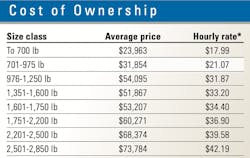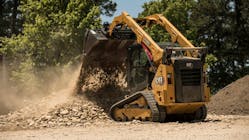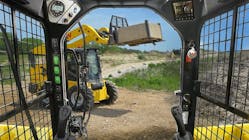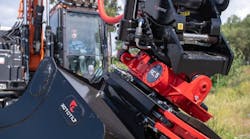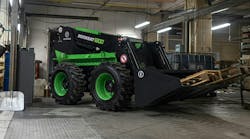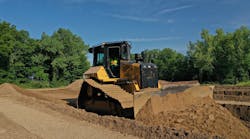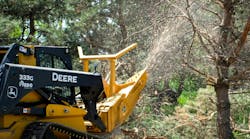Nathan Ryan, product manager for Wacker Neuson compact track loaders, keys in on training—for two different reasons.
“Training operators is helpful when looking to lower CTL operating costs; this means both training for proper usage and daily maintenance,” Ryan says. “If operators are trained to grease all required pivot points daily or notice under-tensioned tracks, they can avoid costly maintenance. When it comes to operation, training operators to use Y-turn patterns or gradual turning rather hard 90-degree turns will prolong track life. Other practices like training operators to operate at lower throttle when permissible, or reducing the machine to idle when work is paused, will help lower fuel usage.”
Idling’s effect on costs is also top-of-mind for Kubota CE product operations manager Tim Boulds.
“On the job, one of the biggest things a manager can do is control idle times on the machines,” says Boulds. “This controls and reduces fuel usage along with needlessly adding engine hours and wear and tear, while reducing a machine’s warranty time frame. Part of controlling the idle time is to ensure your training of employees encompasses good operating practices.”
How to keep CTL costs down
* Hourly rate represents the monthly ownership costs divided by 176, plus operating cost. Unit prices used in this calculation: diesel fuel at $3.07 per gallon; mechanic’s wage at $59.58 per hour; and money costs at 3.625 percent.
Source: Powered by EquipmentWatch, 800.669.3282
Controlling CTL costs through maintenance
“First and foremost, managers should encourage operators to read the owner’s manual,” says Buck Storlie, product line manager for ASV compact track loaders. “Critical advice for proper operation, inspection, and cleaning specific to individual machines are listed and should be followed to keep operating costs low. Put in place a preventative maintenance schedule following manufacturer recommendations in the manual.
“Also make sure to clean the machine regularly, particularly the undercarriage, to prevent build-up of material that could increase component wear,” Storlie says. “Use high-performance fluids and lubricants that match the operating conditions you’ll be working in,” Storlie says. “ASV machines, for example, are built for and shipped with fluids and lubricants designed for operation in extreme ambient temperatures from -22 F to 118 F.”
As undercarriage costs are a major component of operating costs, undercarriage care for compact track loaders is critical.
Kevin Coleman, product specialist for Caterpillar compact track loaders, points out that his company’s CTL undercarriages are not unlike those of large excavators or dozers, and keys on three important maintenance practices.
“One is to maintain proper track tension,” Coleman says. “Maintaining proper track tension will increase the life of not only the track, but also other undercarriage components such as bearings, seals, idler wheels, and mid-wheels. Operating with a track too loose can result in reduced track life; operating with a track too tight can put additional stress on the track and the rest of the components in the undercarriage.
Second, Coleman says keep the undercarriage clean. “Keeping your undercarriage clean will increase the life of the components, seals, bearings, and other moving components in the undercarriage. Pay particular attention to cleaning between roller and idler wheels and around the drive sprocket where material can accumulate and cause additional wear.
“Finally, there’s lubrication. For over a decade, Cat rubber track loaders have featured a torsion suspension undercarriage that absorbs shocks and vibration encountered on the job site for improved material retention and an extremely comfortable ride,” Coleman says. “This torsion suspension undercarriage utilizes four torsion axles which require daily greasing. These grease points are easily accessible from the ground. Regular greasing is important to ensure the suspension system will continue to provide performance for the customer.”
Gregg Zupancic, product marketing manager for Deere compact track loaders, takes a similar route, stressing that the easier maintenance is to perform, the more likely it is to be done—and cost savings will follow.
“We strive to help customers manage their equipment, and make machine maintenance an easy task versus a challenging ‘to-do’ through upgraded design and collaboration with our customers over time,” Zupancic says.
“John Deere recommends changing oil in 500-hour intervals, and to use the specific fluid types listed in the Operator’s Manual to ensure the machine is running at its best,” Zupancic says. “Checking fluid levels can be a quick task, as our compact track loaders and skid steers were designed to have color-coded fluid fills for easy identification, and easy access to the filters and fills so they can easily be checked on a regular basis.”
Zupancic also touches on the undercarriage and adds attachments to the preventive maintenance mix.
“While certain points of a machine can be checked on a weekly or monthly basis, we recommend checking undercarriages on compact track loaders daily,” he says. “Frequent undercarriage check-ins are essential to the upkeep of the machine overall. Operators should also check that the hydraulic and fluid latches are locked on compact track loaders, especially when rotating out attachments on the machine. Failing to check could lead to damage of the machine or an attachment, ultimately reducing unexpected costs associated with damages and preventing unnecessary downtime.”
Telematics have been added to Deere compact track loaders, Caterpillar compact track loaders, and other manufacturers have also been busy adding technology to compact machines, which can help managers track and control costs.
“One way to help keep an eye on maintenance needs and maximize efficiency is to utilize a telematics tool such as JCB LiveLink,” says Chris Trampush, product manager for JCB compact track loaders for JCB North America.
“Telematics takes the guesswork out of regularly scheduled maintenance as well as helps a manager maintain oversight on any day-to-day operation issues as well,” Trampush says. “LiveLink can provide general usage statistics including fuel consumption, idle time, and can also control the hours of the day a machine can be in operation.”
The latest CTL technology
The recent Conexpo in Las Vegas featured some noteable technological upgrades in CTLs. John Deere released its SmartGrade 333G compact track loader (see top image), touting it as the industry’s first CTL with integrated grade control technology that operators would normally see on larger construction equipment. Deere’s SmartGrade system had previously been released on dozers and motor graders.
The goal is to allow CTL users to automatically complete grading tasks faster with fewer passes and less rework compared to working without grade control technology.
In what could be looked at as a reaction to the Case DL450 compact dozer loader (promoted as “The Minotaur” in a long marketing campaign), Deere also launched DozerMode, a control solution that enables the EH joystick control system to function like a crawler dozer—with the push of a button. DozerMode is designed for operating the machine-equipped, Deere-designed and -built, six-way dozer blade attachment that can both cut a grade and spread materials.
ASV released several small compact track loaders, including an RT-50 Posi-Track loader. And the company is backing its unique track system with a new warranty.
“We recently introduced the market’s first anti-derailment guarantee to show our confidence in our undercarriage design,” Storlie says. “Multiple innovative features come together in the Posi-Track undercarriage to achieve derailment-free operation, including a flexible track for more track on the ground and the ability to kick out stuck material, a large number of contact points, and internal and external guiding lugs.
“We offer the industry’s only internal positive drive to improve efficiency and reduce track wear,” Storlie says. “The undercarriage is also a single-rail open design, allowing material to spill out and reducing component wear. The combination of these features and numerous other advancements over the past 5 years allows us to offer the also-recently introduced 2-year, 2,000-hour warranty that includes the track, something no one else offers.”
Caterpillar has also made news with what it calls Smart Attachments for its Cat D3 Series compact track loaders.
“This advanced machine technology recognizes the Smart Attachments and tailors the controls and operator information to match the tool and the task,” Coleman says. “It ushers in a higher level of integration between the machine and new Smart Attachments. This integration allows for better machine utilization and a better finished product by delivering easy, intuitive operation of the new grading and excavating Smart Attachments.”
Coleman says three things comprise the new smart technology and Smart Attachments: attachment recognition, tailored controls, and special information/control screens.
“Smart technology starts with ‘Plug & Play’ attachment recognition, which means the machine understands when a Smart Attachment is connected,” Coleman says. “It also knows which Smart Attachment is connected. With the press of button, the operator can enter the Attachment Control mode.
“The machine’s existing joystick controls are changed from the drive/implement control functionality and are now tailored to meet the control needs for the specific Smart Attachment that has been attached,” Coleman continues. “This allows the machine’s joystick controls to be tailored to now provide specific control actions for the recognized Smart Attachment. No need for extra controls or using multiple buttons and switches to control some of the complex hydro-mechanical tools.”
The smart technology also provides additional control and/or information for the operator via special display screen(s) on the in-cab advanced display monitor.
“With a simple press of the button again, the operator returns to machine control mode and the joysticks return to their original drive and implement control functionality,” Coleman says.
JCB recently launched the 2TS-7T Teleskid. “The Teleskid range stands out amongst the market because of the versatility it offers compared to traditional compact track loaders,” Trampush says. “The Teleskid allows an operator to do a variety of tasks not possible with a competitive compact track loader, such as loading a truck from one side and digging below grade.”
What's new in compact track loaders
Manufacturers are continuing to invest in the CTL market and increase managers’ choices because it has been one of the more robust machine categories for a long period of time. Most of the same OEMs also make skid steers, and they are quick to defend that category as continuing to be viable.
“The CTL market is up and has grown considerably over the last several years,” says Aaron Haynes, global product manager for Gehl compact track loaders. “To put that in perspective, we’ve seen a 61 percent increase in North American CTL market volume when comparing 2015 to 2019. More recently, we have seen a 14 percent increase in market volume between 2018 and 2019.”
Trampush says the current retail market for skid steer and compact track loaders is weighted approximately 70 percent CTLs to 30 percent skid steers. “Compact track loaders can work in all varieties of applications with no limitation due to conditions,” he says. “Wheeled skid steers, while very valuable in their own right, tend to face more limitations when it comes to ground conditions, reducing the amount of applications and environments in which they can work.”
Sarah Peckscamp, loader marketing manager for Bobcat compact track loaders, attributes it to profitability.
“The industry continues an upward trend in popularity of CTL models over skid steer loaders in various markets,” Peckscamp says. “In addition to working in soft, sandy conditions, contractors often work in climates with wet and muddy ground conditions. For this reason, CTLs have allowed customers in many parts of North America to extend their working seasons to generate days—and even weeks—of extra income.”
OEMs were mixed on the market effects of Covid-19 on the market at press time, as most construction was still taking place.
“The compact track loader market has been increasing in each of the past 10 years, and it does not show signs of stopping, even in this current environment,” Zupancic says. “Looking at the beginning of 2020 through April, we are seeing the market increase 7 percent, and customers have still been purchasing compact track loaders.”
Kubota’s Boulds has a different take. “As we are heading into Q2 of 2020, amid the Covid-19 pandemic, we anticipate a slowdown of the market growth in the compact equipment industry, until the nation is back on its feet after this virus is under control,” he says.

